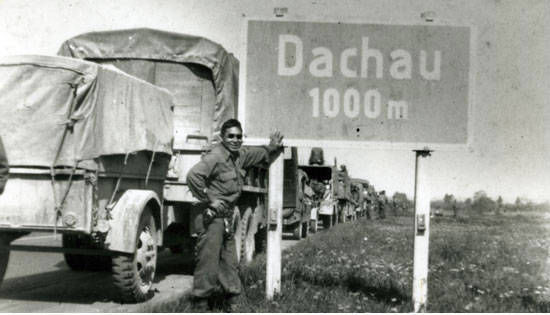LIHUE — The Unlikely Liberators exhibit isn’t just to recognize the heroes of yesterday. It’s also to warn generations to come about the dangers of war. “The thing about it is keeping a part of history. We don’t want history
LIHUE — The Unlikely Liberators exhibit isn’t just to recognize the heroes of yesterday. It’s also to warn generations to come about the dangers of war.
“The thing about it is keeping a part of history. We don’t want history to repeat itself,” said Edward Kawamura Sr., Kauai Veterans Council commandant.
The exhibit begins Sept. 5 and runs to Sept. 27 at the Kauai Veterans Center. Made up of photographs and documents from family members and museums around the world, The Unlikely Liberators exhibit showcases World War II’s unlikeliest heroes, the Nisei soldiers of the 522nd Field Artillery Battalion.
Part of the 442nd Regimental Combat Team, a segregated unit made up primarily of Japanese Americans who fought for the United States in World War II, the soldiers of the 522nd Battalion were impacted by the war before they even stepped foot onto the battlefield.
“These liberators were in internment camps,” Kawamura said. “And to prove that they were loyal to their country, they joined the U.S. Army. They fought throughout Europe and are the most decorated unit the Army had.”
In the war’s closing days, the 522nd came across prisoners from the sub-camps of Dachau. Known as the Dachau Death March, prisoners were forced to march as the Nazis attempted to destroy evidence of the holocaust.
On April 25, 1945, about 15,000 prisoners from the sub-camps around Dachau were moved to the Dachau camp and then sent on the death march to the Austrian border. The prisoners were from the Jewish labor camps of Landsberg, Kaufering and Uting. The Nazis intended to murder all living eyewitnesses.
A week later, around 6,000 prisoners were still alive. Some died of starvation, others in failing health were shot along the route.
The Nazis began to flee upon seeing an advance patrol of the U.S. Army, soldiers of the 522nd.
“They battled and won that place there,” Kawamura said. “They opened the doors but the problem was, the Jews looked out the door and saw the Japanese. And the Jews knew that the Japanese were allies with the Germans.”
Over the next several days, the Nisei soldiers provided aid to the survivors, transporting them to Waakirchen until a medical detachment could take over.
In addition to educating other generations about these soldiers and the atrocities of the second World War, Kawamura wants the public to understand the sacrifice Japanese-American soldiers made for their country.
“We want to open the eyes of the public what freedom meant,” he said. “They were loyal citizens, but they had to go prove themselves in war and battles. The exhibit is to open a dialogue with the younger generation to make sure we don’t have a mistake like this again.”
Kawamura added that Clinton Shiraishi, a World War II veteran of the 522nd, will be in attendance at the exhibit, along with members of the Jewish faith.
“We’re very happy to have the Jewish community on Kauai coming,” he said. “They’re going to partake in the event as well because it’s part of their history, too.”
The Unlikely Liberators Exhibit was curated by military historian Eric Saul and documents the encounters between Nazi concentration camp prisoners and Nisei soldiers of the 522nd.
Utilizing original photographs and negatives still held by the veterans and their families, the exhibit will include photographs from the U.S. Holocaust Memorial, the Yad Vashem museum in Jerusalem, the Simon Wiesenthal Center archives in Los Angeles, and the KZ Gedenkstätte Dachau (Dachau Memorial Museum).
The exhibit is free and open to the public.


